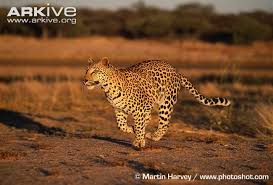Post by dinosauria101 on Oct 19, 2019 19:54:41 GMT 5
Leopard - Panthera pardus
The leopard, Panthera pardus, is a member of the Felidae family and the smallest of the four "big cats" in the genus Panthera, the other three being the tiger, lion, and jaguar. The leopard was once distributed across eastern and southern Asia and Africa, from Siberia to South Africa, but its range of distribution has decreased radically because of hunting and loss of habitat. It is now chiefly found in sub-Saharan Africa; there are also fragmented populations in Indonesia, Pakistan, India, Sri Lanka, Indochina, Malaysia, and China. Because of its declining range and population, it is listed as a "Near Threatened" species by the IUCN. Leopard are agile and stealthy predators. Although smaller than other members of the Panthera genus, they are able to take large prey due to their massive skulls that facilitate powerful jaw muscles. Head and body length is between 125 and 165 cm (49 and 65 in), and the tail reaches 60 to 110 cm (24 to 43 in). Shoulder height is 45 to 80 cm (18 to 31 in). The muscles attached to the scapula are exceptionally strong, which enhance their ability to climb trees. They show a great diversity in size. Males are about 30% larger than females, weighing 30 to 91 kg (66 to 200 lb) compared to 23 to 60 kg (51 to 130 lb) for females. Large males of up to 91 kg have been documented in Kruger National Park in South Africa; however, males in the South Africa's coastal mountains average 31 kg. This wide variation in size is thought to result from the quality and availability of prey found in each habitat. Smaller sized leopards also are known in the deserts of the Middle East. Its body is comparatively long, and its legs are short.

encrypted-tbn0.gstatic.com/images?q=tbn:ANd9GcT_R9ZyGEQyTnqI90VOp57Rut5B0rcMLGyBFht86RZfsfrKH72Nyw
Plains (Common) Zebra - Equus quagga
The plains zebra (Equus quagga, formerly Equus burchelli), also known as the common zebra or Burchell's zebra, is the most common and geographically widespread species of zebra. The Plains zebra's range stops short of the Sahara from southern Sudan and southern Ethiopia extending south along eastern Africa, as far as Zambia, Mozambique, and Malawi, before spreading into most southern African countries. They are regionally extinct in Burundi and Lesotho, and they may have lived in Algeria in the Neolithic Era.[ The plains zebra is mid-sized, smaller on average than the other two zebra species, and thick bodied with relatively short legs. There is some variation in size, based on the animals' condition and subspecies. Adults of both sexes can stand from 1.1 to 1.47 m (3.6 to 4.8 ft) high at the shoulder, are 2 to 2.5 m (6.6 to 8.2 ft) long, not counting a 50 cm (20 in) tail, and weigh 175 to 387 kg (390 to 850 lb). Males may weigh 10% more than females.

Credit to Wikipedia
The leopard, Panthera pardus, is a member of the Felidae family and the smallest of the four "big cats" in the genus Panthera, the other three being the tiger, lion, and jaguar. The leopard was once distributed across eastern and southern Asia and Africa, from Siberia to South Africa, but its range of distribution has decreased radically because of hunting and loss of habitat. It is now chiefly found in sub-Saharan Africa; there are also fragmented populations in Indonesia, Pakistan, India, Sri Lanka, Indochina, Malaysia, and China. Because of its declining range and population, it is listed as a "Near Threatened" species by the IUCN. Leopard are agile and stealthy predators. Although smaller than other members of the Panthera genus, they are able to take large prey due to their massive skulls that facilitate powerful jaw muscles. Head and body length is between 125 and 165 cm (49 and 65 in), and the tail reaches 60 to 110 cm (24 to 43 in). Shoulder height is 45 to 80 cm (18 to 31 in). The muscles attached to the scapula are exceptionally strong, which enhance their ability to climb trees. They show a great diversity in size. Males are about 30% larger than females, weighing 30 to 91 kg (66 to 200 lb) compared to 23 to 60 kg (51 to 130 lb) for females. Large males of up to 91 kg have been documented in Kruger National Park in South Africa; however, males in the South Africa's coastal mountains average 31 kg. This wide variation in size is thought to result from the quality and availability of prey found in each habitat. Smaller sized leopards also are known in the deserts of the Middle East. Its body is comparatively long, and its legs are short.
encrypted-tbn0.gstatic.com/images?q=tbn:ANd9GcT_R9ZyGEQyTnqI90VOp57Rut5B0rcMLGyBFht86RZfsfrKH72Nyw
Plains (Common) Zebra - Equus quagga
The plains zebra (Equus quagga, formerly Equus burchelli), also known as the common zebra or Burchell's zebra, is the most common and geographically widespread species of zebra. The Plains zebra's range stops short of the Sahara from southern Sudan and southern Ethiopia extending south along eastern Africa, as far as Zambia, Mozambique, and Malawi, before spreading into most southern African countries. They are regionally extinct in Burundi and Lesotho, and they may have lived in Algeria in the Neolithic Era.[ The plains zebra is mid-sized, smaller on average than the other two zebra species, and thick bodied with relatively short legs. There is some variation in size, based on the animals' condition and subspecies. Adults of both sexes can stand from 1.1 to 1.47 m (3.6 to 4.8 ft) high at the shoulder, are 2 to 2.5 m (6.6 to 8.2 ft) long, not counting a 50 cm (20 in) tail, and weigh 175 to 387 kg (390 to 850 lb). Males may weigh 10% more than females.

Credit to Wikipedia





